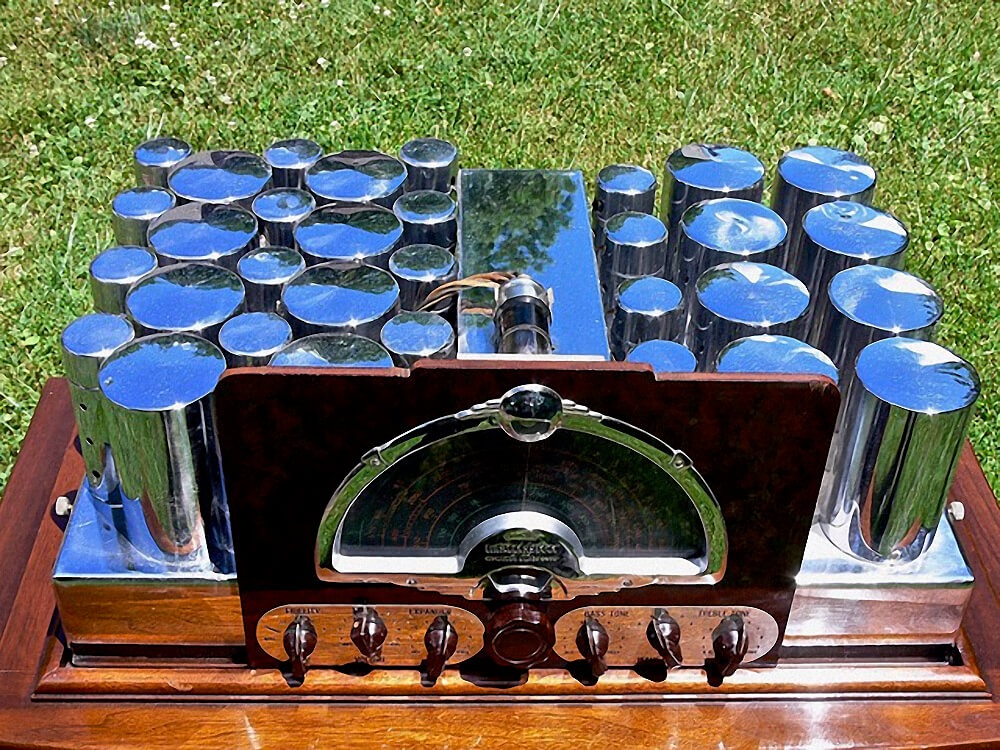This is an Encore of a Musings that looks at Radio Broadcasting’s earliest decades from a unique perspective … the receiving end!
A while back, my longtime friend, Bill LeGall, sent me three photos — including the one above — of what he told me was a McMurdo Silver radio. Other than recognizing the unique-looking device was truly a radio receiver from a bygone era, the name McMurdo Silver was totally unfamiliar to me.
Now if you had said it was an Atwater Kent, it would have been a different story, as that’s a name I’ve known since childhood, when my family owned an Atwater Kent console radio. A short, direct answer to the question is — like Atwater Kent — McMurdo Silver was a man and his “high end” receivers were marketed under his own name.
To get answers, my first action was to contact Brian Belanger, the curator of the National Capital Radio & Television Museum in Bowie, Maryland, of which I am a member. Brian responded promptly with copies of several published articles about “the life and times” of Mr. Silver, from which I’ve drawn much of what I’m about to share here. (At the end of this Musings, I’ll include links to sources of information about his life and receiver developments.)
McMurdo was born in 1903, had an early childhood that was considered “unremarkable,” and was a rather poor student in school. However, at age nine came the sinking of the Titanic, which brought wireless communication to the national news, and the new technology immediately drew McMurdo’s interest. While he jumped into buying radio parts and learning all he could, the coming War caused a ban on civilian radio … bringing his wireless experimentation to a halt.
One thing that was not lacking was ambition. By the war’s end in 1918, he had dropped out of school and — although only 15 years or age — took a job as a Wall Street messenger to earn money to continue his radio-related experimenting, focusing on wireless technology advances resulting from the war. Moving forward, after finally securing a high school diploma, he was able to enroll in New York’s acclaimed Cooper Union Technical School as an engineering student.
During the first half of the 1920s, he worked for a variety of firms dealing with radio components while continuing his own experimentation, always staying on the cutting edge of new developments … while always dreaming of launching his own company.
Keep in mind here, we are at the beginnings of the radio broadcasting industry, with the first stations just starting to deliver small schedules of programming to the public in 1920. Atwater Kent began to build and deliver his first receivers in 1921, really ahead of the curve, as it was 1922 before a steady flow of stations were signing on. In these early years, companies such as McMurdo worked for already-designed receivers and produced and sold the parts needed for people to assemble their own receiving units.
In 1924, McMurdo’s grandfather died, leaving him sufficient funds to go out on his own. He joined forces with cousin John Marshall as a partner and founded Silver-Marshall, Incorporated in Chicago, entering the business of manufacturing radio parts and kits, constantly introducing new models embodying new circuitry and designs that he himself had conceived — one company ad claims that McMurdo Silver “is officially credited with 40 major radio advancements.”
As time passed, finding the sale of receiver kits and parts on the decline, he chose to move into producing complete radio consoles and proceeded to build a new factory to handle the expansion. However, his timing was terrible, as the year was 1929 … the stock market crash came just months later, bringing on the Great Depression.
With the economy going south and most people no longer having money to buy a radio, on October 8, 1932, Silver-Marshall was forced to declare bankruptcy. Not being deterred, McMurdo soon launched a new company, McMurdo Silver, Incorporated, with a new goal: To produce the finest radio receiver money could buy!
It wasn’t long before he introduced his first product, the Masterpiece … the original predecessor to the grand receiver shown here. Even with a shrunken customer base, the 1930’s decade saw much activity in the refinement of radio receivers and competition in building so-called “high end” units!

This placed him in direct competition with another gentleman following much the same route of selling radio parts and kits before entering the “high end” console arena — E. H. Scott, also based in Chicago. (Before your mind goes into overdrive, do not confuse this Scott with H. H. Scott, the pioneer in FM and FM Stereo receivers … my research finds no connection between the two companies beyond having the same name.) Both men were great promoters and published reviews were pretty much split 50-50 between which of the two men’s receivers was the better performer.
The reason for the demand for these “high end” receivers was two-fold. First, by the beginning of the 1930s, the broadcast station equipment manufacturers — primarily Western Electric and RCA — had begun developing new types of microphones that were able to pick up a much greater frequency range of sounds and with greater clarity; hence, stations were transmitting audio quality closer to what one would hear if present at a live performance. Beneficially, these McMurdo Silver and Scott receivers contained improved circuitry and speakers, enabling the listener to have an enhanced listening experience.
Secondly, both manufacturers developed improved circuitry for the tuning portion of the receiver as well, allowing these set owners to enjoy DX’ing … the activity of seeking to pick up radio stations from far away, even across the oceans, which was quite a popular sport that many enjoyed with great success. Fortunately, there were far fewer stations operating prior to World War Two and, more importantly, far fewer electrical devices creating interference and static, especially for AM reception. (As an aside, as I write in my radio memoir, even with my 1946 model Philco table radio, I had good success in picking up distant stations — although maybe not from as great a distance or with the clarity of these “upscale” units.)
Following the introduction of his initial Masterpiece unit, McMurdo followed the automobile manufacturers’ routine of releasing a new and improved version of the receiver — designated Masterpiece II through VI — every fall. The unit displayed here is either a Masterpiece V or VI … which is based on the number of tubes visible; earlier versions contained fewer tubes. Comparing these photos with groups of photos found elsewhere showing both versions, I find some possible distinguishing elements, but it’s unclear as to which unit is being shown. Otherwise, of the entire series, most who are qualified to make such judgments consider the Masterpiece V to be the best of the series.

Sadly, there would be no Masterpiece VII, as these McMurdo Silver radios were not cheap to produce without there being a reduction in quality. At the same time, McMurdo found himself being out-promoted by Mr. Scott … finally pushing the Silver company into a money-losing position. Come 1938, with bankruptcy the only option, what was left of his company was sold to his rival, E. H. Scott.
Unlike previous times, there would be no real comeback following this setback. McMurdo would work as an engineer for other companies during the war years and establish a new McMurdo Silver company in 1945, which built test equipment and other items for the industrial and commercial markets … but nothing on the level of the acclaimed Masterpiece receivers, considered among the best radios ever built!
Being a person who spent several decades programming and managing FM radio stations as well as being a pioneer listener to FM radio in the late 1940s… I cannot help but draw a comparison between McMurdo Silver and the inventor of frequency modulation (FM) transmission, Edwin Howard Armstrong — both were brilliant engineers, each with great radio-related developments to their credit, and entrepreneurial . . . both would become depressed with their life, see no “bright sky” for their life ahead and die by suicide, McMurdo in 1948 at just age 45 and Armstrong in February 1954 — truly a sad ending to both men’s stories … and an “escape route” that today is reaching epidemic proportions!
Before closing, I must acknowledge Bill LeGall — whom I mentioned at the outset of this Musings — and thank him for sharing these photos, which led me to learn the story of another of history’s great inventors. Bill is the proprietor of Millersound and considered one of the most skilled individuals in the audio speaker repair and reconing field in the nation, if not the world. That’s the reason a collector brought his new McMurdo Silver find over to show off to Bill.
As for the sources utilized for this article … as noted, much came in the form of copies of articles provided by Brian Belanger. However, you can find more about the man and his radio at these links:
Mid-Atlantic Antique Radio Club
The New Mexico Radio Collectors Club’s article about McMurdo Silver, Incorporated
The Southern California Antique Radio Society’s page on the Masterpiece receivers.
As always, I would love to read whatever comments you might have … so please use the comment form below to send them along!
Thank you and thank you for reading – now do let me hear from you.




Marlin,
Loved this edition!!! Right up my alley !
Dave Hancock
Pleased to know you enjoyed this story from radio history! Thanks, Dave.
WOW – what an interesting article.
Like you, I had never heard of this radio receiver.
Thanks for sharing this story again.
Thanks, Dick! Glad to know that I was not alone in never having heard of this radio!
Great story on a legendary radio and man. I knew of Silver and the rigs. There was considerable news-coverage of an AM radio station DX(long distance receiving) duel between Bing Crosby and Silver in the 1930’s.
Update: The DX duel was between an actor named Harold Arlen and Crosby, in 1934. And it was AM + shortwave DX’ing. However, both celebrities used a McMurdo Silver Masterpiece, donated by Silver. Bing Crosby won.
Thank you, Jay … appreciate your sharing both stories.
Awesome read. Thanks for the research. I just received a mcmurdo Masterpiece V in rough shape. I’m gonna start restoring it. Not tons of information out there. Thanks for the great history!
I wish you good luck in your endeavor, Blaise.
If you need more information, feel free to contact Brian Belanger through the link provided in my article, who, as noted, was my source!